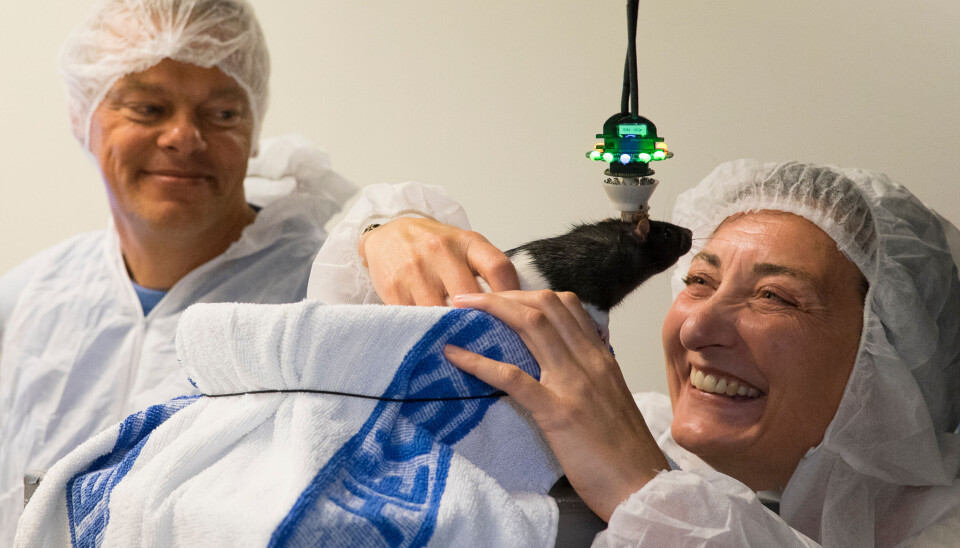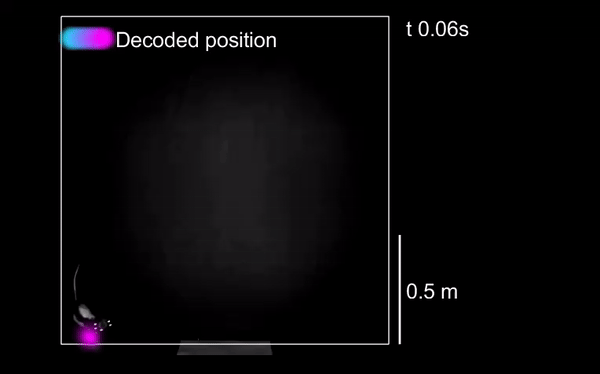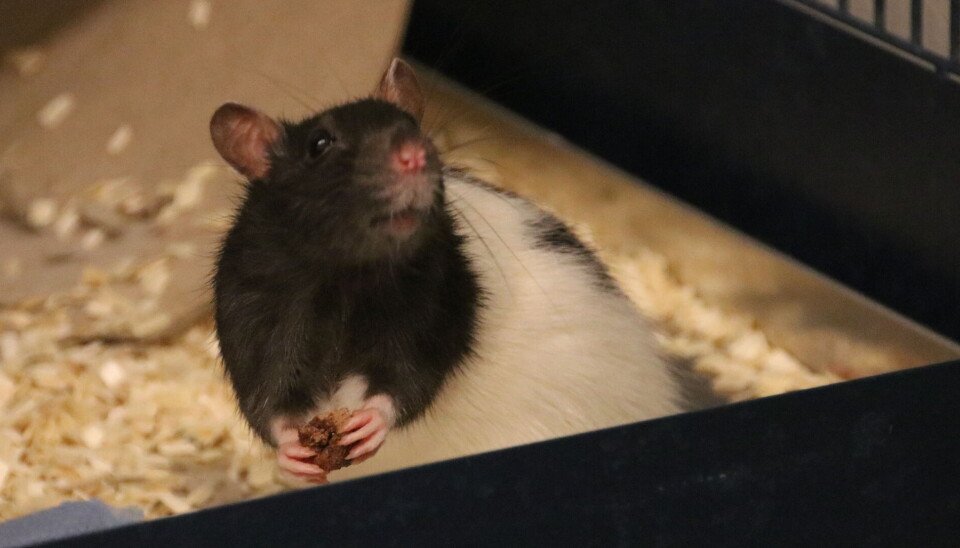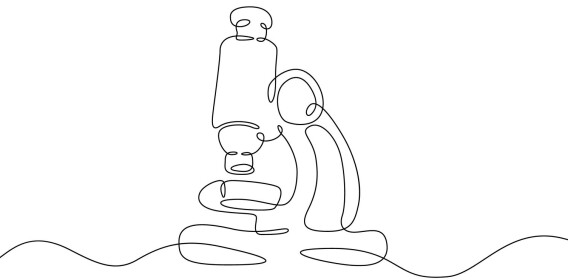New discovery about the brain's sense of place from Nobel Prize winners:
"Absolutely shocked that this exists," says May-Britt Moser
The brain scans its surroundings in a steady rhythm, like an engine that only turns off during deep sleep.

The brain is not only concerned with where we are right now.
It also explores places we haven't been yet.
This is the conclusion of a new study from the Mosers and their colleagues at the Kavli Institute for Systems Neuroscience at NTNU.
Rats moving around in a box navigate in a surprising way.
Even when a rat walks in a straight line, its brain does not simply track the direct path on its mental map.
"Within just a few milliseconds, brain cells sweep out into the surroundings and map them," Edvard Moser tells sciencenorway.no.
A comparison to bats
These sweeps happen entirely within the brain.
And they occur in a steady rhythm, shifting from right to left.
This is demonstrated in the study published in the scientific journal Nature.
Edvard Moser compares what happens in the rat brain to an ability that bats have.
Some bats emit sound signals alternately to the left and right. This is how they map their surroundings.
Rethinking the brain's internal map
This discovery challenges existing ideas about how our sense of place functions, according to the Mosers.
The former couple discovered grid cells in 2005.
These cells light up in a structured coordinate pattern when mice or rats move around in a box.
The Mosers were awarded the Nobel Prize for their groundbreaking work on grid cells in 2014.
Now, however, neuroscientists may have to reconsider how the brain constructs its internal map.
" We previously believed that for an environment to be fully mapped, a rat would need to physically traverse nearly every point within it," says May-Britt Moser.

Would have been impossible to detect five years ago
The new study now suggests that previous assumptions were incorrect.
"What we didn't know, and are absolutely shocked to discover, is that when the animal moves forward, it simultaneously has these spotlights or sweeps that gather extra information along the way," says May-Britt Moser.
Five years ago, detecting this would have been impossible, Edvard Moser points out.
The sweeping motion changes direction within milliseconds.
Captures the crackling of thousands of brain cells
Measuring this phenomenon became possible with a small innovation called Neuropixel electrodes.
This tiny device functions like an advanced microphone, capable of detecting the brain's electrical signals.
Here you can see how the researchers present the new technology:
The Neuropixel probe, which weighs just over a gram, is implanted into the rats' brains.
The microphone can then record the crackling sounds of thousands of brain cells firing simultaneously.
"Extremely impressive work"
In this new study, researchers listened to both grid cells and place cells.
While grid cells create a kind of coordinate system, place cells are crucial for forming memories.
Neuroscientist Tor Stensola was part of the Moser research group from 2008 to 2015.
At that time, they were only able to measure a few brain cells at once.
"What they're doing now is on a completely different level. There are several aspects of this research that are extremely impressive, both experimentally and theoretically," Stensola says about the new study.
He is currently an associate professor at the University of Agder, researching other brain functions.
Brain signals reveal the rat's position
The new technology makes it possible to interpret brain activity.
A video of the rat moving around in a box can be linked to the signals from thousands of brain cells.
This allows researchers to decode the rat's position.
The specific brain cells that fire signals provide a clear indication of where the rat is located in the real world.
"If you have access to the activity of many, many brain cells, and you're a computer, you can predict exactly where the rat or mouse is at that moment, because the combined activity is unique to that specific location," says Edvard Moser.
As the rat moves through its surroundings, activity shifts on its internal map.
One of the studies demonstrating this was published by the Mosers and their colleagues in Nature in 2022.
The sweeping motion is as rhythmic as a metronome
Now that computers can determine the rat's approximate position just by analysing brain signals, researchers can understand more of what happens in the brain.
By measuring the brain’s crackling activity down to the millisecond, they uncovered something new.
The rats did not simply follow the direct path on their internal map.
Instead, they made sweeping motions to the right and left, rhythmically, like a metronome.
This discovery surprised Tor Stensola.
"This reveals a completely new property of the brain," says the researcher.

The animation above (Vollan et al., 2025) shows the sweeps in the mental map, overlaid on a video of how a rat moves in the real world.
Artificial intelligence mimicked the rats
But what do the rats achieve with these sweeps?
To get closer to an answer, the research team created a computer model based on artificial intelligence.
By replicating rat brain activity on a computer, the researchers could test different ways of navigating.
The model showed that these internal sweeps were the most efficient method for mapping the environment as quickly as possible.
Still, it is too early to draw firm conclusions, Stensola points out.
"We don't fully understand why the rats do this. That's important to mention. But it's still incredibly exciting," he says.
The same pattern appears during light sleep
May-Britt Moser and Edvard Moser have presented their new data at multiple conferences.
There, they have received many suggestions for explanations from other researchers.
Could the sweeps be linked to the rhythm of the rats' movement? Could they be looking around from side to side?
But the NTNU researchers always give the same response.
"We see the same thing during sleep," says May-Britt Moser.
During the lightest sleep phase, REM sleep, the same right-to-left movements appear in the rat's brain.
This means the phenomenon occurs even when the rats are completely still and not receiving any sensory input.
Only in deep sleep does the sweeping motion stop.
Not dependent on sensory input
Because of this, researchers believe these sweeps could be a fundamental mechanism for the sense of place and orientation.
"It's essentially programmed into the brain," says Edvard Moser.

The fact that this occurs entirely within the brain is fascinating, says Tor Stensola.
"What's incredible about this system is that it operates on its own. It does things independently of sensory input or the exact location of the animal," he says.
Want to test what happens when rats experience something new // Testing how rats react to new experiences
While bats use sound waves to scan their environment, rats appear to map their surroundings inside their brains.
So the question is: Do these movements have any connection to what is happening in the real world?
The new study does not answer this.
However, the research team have a clear theroy.
"We suspect, though we haven’t tested it here, that this mechanism helps the brain construct an internal map of the environment. If something interesting happens, we believe the signals are modified," says Edvard Moser.
Testing this theory will be the next step for the NTNU research team.
Could these sweeps unlock memories?
Stensola also speculates that these sweeps might serve another function.
Perhaps they help retrieve memories.
"If we enter a house we haven't visited in a long time, it brings up memories we had in that house," he explains.
The rat may also have stored memories from the place it is in.
To retrieve them from the subconscious, it might be useful to stray slightly from the path.
By sweeping from side to side within its brain's internal map, the rat may recognise familiar places.
"So you can imagine that this system broadens the path the rat is following to check for associations in its memory," says Stensola.
———
Translated by Alette Bjordal Gjellesvik
Read the Norwegian version of this article on forskning.no
References:
Gardner et al. Toroidal topology of population activity in grid cells, Nature, 2022. DOI: 10.1038/s41586-021-04268-7
Vollan et al. Left-right-alternating theta sweeps in entorhinal-hippocampal maps of space, Nature, 2025. DOI:

Subscribe to our newsletter
The latest news from Science Norway, sent twice a week and completely free.




































